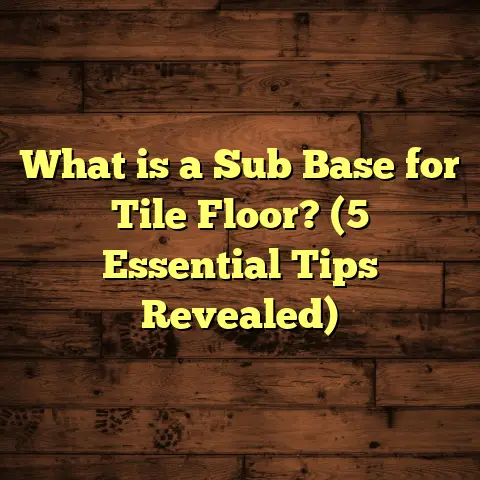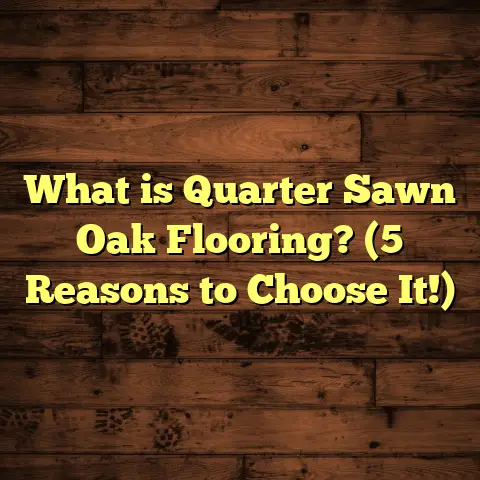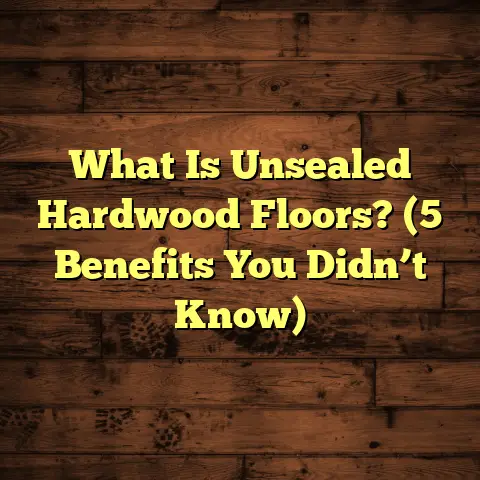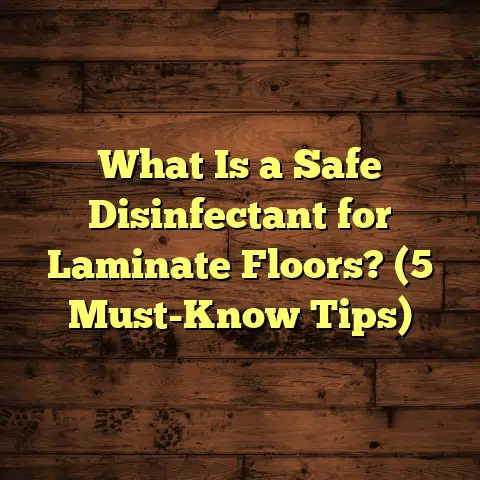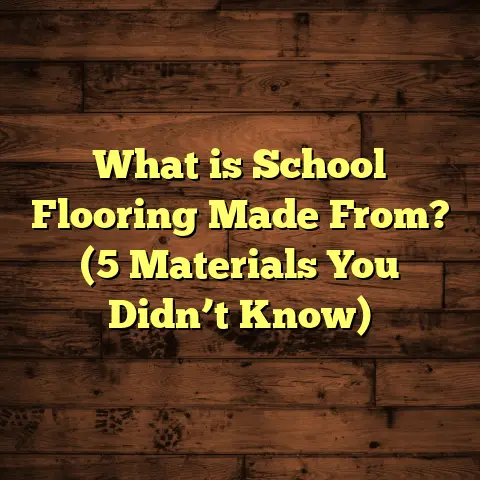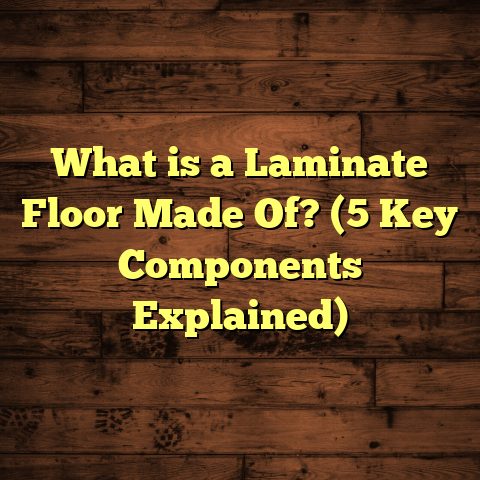What is a Vapor Barrier for Laminate Floors? (5 Key Benefits Explained)
Waterproof flooring options have become a big talking point in my work as a flooring contractor. Whether it’s a kitchen, basement, or even a living room, clients want floors that not only look great but can withstand moisture without damage. Laminate floors often come up because they combine the look of wood with easier maintenance and budget-friendly installation. But here’s the thing — laminate floors aren’t waterproof by themselves. That’s why I always stress the importance of vapor barriers when installing laminate.
What Is a Vapor Barrier for Laminate Floors?
Let me start with the basics: a vapor barrier is a layer of material installed beneath laminate floors to stop moisture from creeping up through the subfloor. It’s usually made of plastic sheeting — often polyethylene — and acts as a shield that blocks water vapor from reaching your laminate planks.
Why is this important? Well, moisture can be sneaky. It might not be liquid water on the surface but invisible vapor rising from concrete slabs or damp wood subfloors. This moisture can cause laminate flooring to swell, warp, or even grow mold underneath if left unchecked.
Technical Breakdown: What Makes a Good Vapor Barrier?
Most vapor barriers are made from polyethylene plastic, particularly High-Density Polyethylene (HDPE). This material is chosen for its strength and moisture resistance. The thickness of these sheets ranges from 6 mils to 10 mils or more — where “mil” means thousandths of an inch. To put it simply, thicker sheets provide better protection but can cost a bit more and be harder to handle.
Another critical factor is permeability. This is measured in “perms,” which tell you how much water vapor can pass through a material. A good vapor barrier for laminate floors should have a perm rating below 0.1. The lower that number, the better the barrier is at blocking moisture.
Some advanced vapor barriers are even treated with antimicrobial agents to prevent mold growth right on the barrier itself. Others might have integrated underlayment foam or cork layers for soundproofing and cushioning. These combined systems make installation easier and add extra comfort.
How Are Vapor Barriers Made?
The manufacturing process for vapor barriers involves extrusion, where molten HDPE is pushed through a die to form thin sheets of uniform thickness. These sheets are then cooled rapidly and rolled for packaging.
Additives like UV inhibitors can be mixed into the plastic during extrusion to protect the barrier from sunlight degradation during storage or installation delays.
Some vapor barriers are laminated with a foil layer that reflects heat and adds insulation properties besides moisture protection. This can help keep floors warmer in winter and reduce energy costs slightly.
Why Should You Care About These Details?
When I’m choosing vapor barrier materials for my projects, I always check:
- Thickness: At least 6 mil for most residential jobs, thicker if moisture risk is high
- Tear resistance: Tough enough to handle foot traffic during installation without puncturing
- Perm rating: Below 0.1 to ensure effective moisture blocking
- Compatibility: Works well with the laminate brand and type of underlayment being used
These specs matter because a cheap, thin plastic sheet that tears easily or lets moisture through won’t do the job — and that’s an expensive mistake.
5 Key Benefits of Using a Vapor Barrier Under Laminate Flooring
After installing hundreds of laminate floors over the years, I’ve seen first-hand what happens when you skip this step versus when you don’t. It’s not just about stopping water; it’s about preserving your floor’s beauty, health, and value long-term.
1. Protects Your Floor From Moisture Damage
This is the biggest reason I push for vapor barriers on almost every laminate floor job.
Moisture coming up through concrete slabs or wood subfloors causes the fiberboard core inside laminate planks to swell. This swelling leads to warping, buckling edges, gaps between boards, and lifting corners. Once these issues start, they’re tough and costly to fix.
Data backs this up: studies show subfloor moisture above 3% dramatically increases laminate failure risk. Vapor barriers reduce moisture transmission by up to 95%, making them crucial in basements or slab-on-grade homes where ground moisture is common.
I remember one job in a mid-century home basement where the previous owner installed laminate without a vapor barrier. Within six months, the floor was bubbling and buckling badly due to moisture migrating through cracks in the concrete slab below. After removing that floor and installing a proper HDPE vapor barrier along with underlayment, the new laminate remained flawless for years despite high humidity.
2. Stops Mold and Mildew From Forming Underneath
Moisture trapped under floors creates prime conditions for mold growth — which is not just bad for your floor but also your health.
I once worked on a basement renovation where mold had grown extensively under old carpeted floors due to poor moisture control. We removed everything and installed laminate with an antimicrobial-treated vapor barrier. Six months later, no mold growth was found under the new flooring.
Mold spores can cause allergies, respiratory problems, and unpleasant odors if left unchecked. Vapor barriers cut off their water source by blocking moisture migration.
Some vapor barriers now come with built-in antimicrobial treatments that inhibit mold growth on their surfaces, adding an extra line of defense.
3. Improves Indoor Air Quality
This benefit might not be obvious at first but it’s vital.
Mold spores and mildew growing under floors can eventually become airborne indoors, triggering allergic reactions or asthma attacks in sensitive occupants.
By preventing mold growth with a vapor barrier, you reduce indoor allergens and improve air quality naturally.
In homes with young children or elderly residents prone to respiratory issues, I always recommend vapor barriers as part of a healthy flooring strategy.
4. Extends Your Flooring’s Lifespan and Saves Money
Laminate floors aren’t cheap to replace; upgrading your home’s flooring system is an investment you want to protect.
Using a vapor barrier increases floor durability by preventing moisture-related damage that leads to early failure. Flooring manufacturers often void warranties if proper vapor protection isn’t installed.
From my experience:
- Floors installed over vapor barriers last at least 5-10 years longer compared to those without
- Clients report fewer repairs such as plank replacement or lifting
- Home resale value stays higher because buyers notice well-maintained flooring
I explain this to clients as “insurance” for their investment — spending a little more upfront saves big headaches later.
5. Adds Insulation and Comfort Benefits
Besides moisture protection, vapor barriers sometimes provide slight insulation benefits depending on their composition.
Foil-backed vapor barriers reflect heat back into the room which helps keep floors warmer in winter months.
When combined with foam or cork underlayments, they add cushioning that makes walking on laminate more comfortable and reduces noise transfer between rooms.
I had a client complain about cold basement floors until we added a foil-backed vapor barrier plus thick underlayment beneath laminate — their feedback was immediate: “Feels so much warmer and quieter now.”
My Personal Stories With Vapor Barriers
I want to share two memorable projects where vapor barriers made all
the difference.
Basement Remodel That Stayed Dry
A family wanted hardwood-look laminate in their damp basement but worried about moisture damage.
We used a 10 mil HDPE vapor barrier with taped seams combined with
foam underlayment designed for basements. Installation took extra care
to seal edges up walls and overlap seams properly.
Six months later after heavy rains caused minor flooding outside, the
floor stayed completely dry underneath with zero swelling or warping.
The homeowner said they were so relieved: “I never thought something
so simple could protect my floor this well.”
New Construction Slab Installation
On a new build set on concrete slab, we used a peel-and-stick vapor barrier
product specifically engineered for slabs below laminate flooring.
This product had adhesive backing making installation quick and ensuring
a tight seal against moisture ingress.
After two years, despite occasional water spills near entryways, no issues
have appeared — showing how important picking the right type of vapor
barrier is too.
Some Numbers That Show Why Vapor Barriers Matter
Since I like data as much as anecdotes, here are some stats from industry studies:
- The National Wood Flooring Association (NWFA) reports moisture-related laminate failures account
for nearly 40% of warranty claims. - Subfloor moisture levels above 3% increase laminate plank swelling by over 250% within six months without vapor barriers.
- Polyethylene vapor barriers reduce water vapor transmission rates by up to 95%.
- Homeowners using vapor barriers report 30-50% fewer maintenance problems like warping or delamination over five years.
- Basements often have relative humidity levels from 60-80%, ideal for mold growth if unprotected.
All this matches what I’ve seen on site repeatedly: skipping vapor barriers often means paying thousands later in repairs or replacements.
How I Use FloorTally For Flooring Cost Estimates
Budgeting flooring projects can quickly become overwhelming when factoring in materials like vapor barriers alongside laminate planks, adhesives (if needed), underlayments, and labor costs.
FloorTally is an online tool I use regularly that helps me get accurate cost estimates tailored
to local material prices and labor rates in minutes rather than hours hunting down quotes manually.
It lets me input room dimensions, choose specific materials like thickness of vapor barrier or type of laminate plank, add waste factors (which is key for cutting losses), then instantly see total costs broken down by category.
This makes conversations with clients easier because I can show exactly how adding a quality vapor barrier affects overall project cost without sounding vague or guessing.
For example:
- Adding a 6 mil polyethylene vapor barrier typically adds about $0.50–$1 per square foot.
- But this upfront cost prevents damage that could cost hundreds or thousands later.
- FloorTally helps me balance quality versus budget realistically so clients get what they want without surprises.
Using tools like this also helps me avoid underbidding jobs which is common when people forget about accessories like vapor barriers until late in the process.
Frequently Asked Questions About Vapor Barriers
Can I Skip Using a Vapor Barrier If My Subfloor Is Wood?
If your subfloor is wood plywood upstairs where there’s no direct ground moisture risk
and climate is dry, you might get away without one sometimes. But even then I highly
recommend at least using an underlayment with some moisture resistance built-in.
Concrete slabs or basements? Absolutely no skipping allowed there unless you want trouble fast.
Is Installing a Vapor Barrier Complicated?
It’s fairly straightforward but needs attention:
- Lay sheets flat with overlaps at seams (at least 8 inches)
- Tape seams tightly with waterproof tape
- Extend barrier slightly up walls if possible
- Avoid punctures during installation by walking carefully
Small mistakes like gaps or tears let moisture in negating benefits.
When I train crews we emphasize these details because proper sealing is critical for success.
What Are Signs Moisture Has Damaged My Laminate Floor?
Look out for:
- Buckling or warping planks
- Gaps forming between boards
- Soft spots when stepping
- Musty smells indicating mold growth
If you see these early enough repairs might save your floor otherwise replacement is needed.
Are There Products Combining Vapor Barrier + Underlayment?
Yes! Some brands offer combination products designed specifically for laminate flooring
that integrate foam underlayment with polyethylene vapor barrier layers bonded together.
These speed up installation but tend to cost more upfront than separate layers.
Wrapping Up My Thoughts
I rarely install laminate flooring without first laying down an effective vapor barrier unless I know conditions are perfectly dry and sealed from below — which honestly happens rarely if ever in real life scenarios.
Over the years I’ve seen too many floors ruined by neglecting this step. It keeps floors stable, mold-free, comfortable underfoot, and saves homeowners money by extending lifespan dramatically.
If you’re planning laminate flooring soon—whether DIY or hiring pros—ask about using a proper vapor barrier or consider adding one yourself if you’re handy. Your future self will thank you when your floors look great decade after decade instead of buckled after months!
Got any horror stories or wins related to flooring moisture? Or questions about types of vapor barriers? Shoot them my way—I love talking shop!
